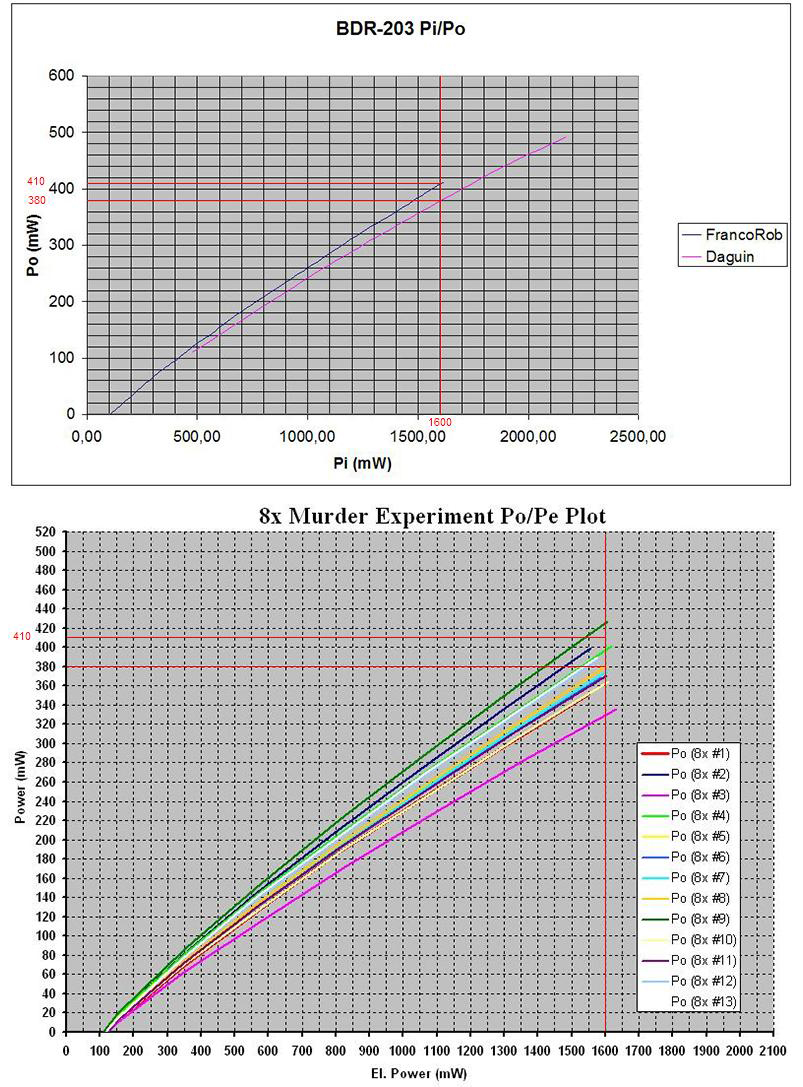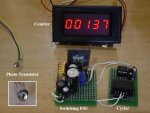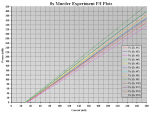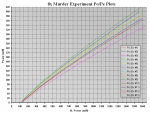IgorT,
So... just so I can better understand what you're saying,
if two diodes were plotted against each other, output power vs. current. Would.. the diode with a larger slope be better off at 320mA, than the diode with a smaller slope?
You're asking about efficiency, which determines how steep the slope is...
Let's say we have two diodes, one puts out more, the other less power at the same current.
My guess, based on some testing and experience is, that the lower efficiency diode would die sooner than high efficiency ones when set to the same current.
I can't say that for sure, i have not killed nearly enough diodes to proove that. But with 6x's for example, practically all normal or high efficiency ones are surviving 190-200mA (in experiments or out in the "wild"), while several low efficiency ones died at those same currents - some in as little as a few hours!
Problem is, the first GGW sleds were of questionable origin. They were sold to us as QC rejects, but there is some evidence they were actually prototyping rejects. Because of that i can't say the results are conclusive, besides it would take killing more diodes than any of us can afford to be able to say this for sure..
There are many factors involved, when it comes to how long a diode will last. And it's quite complicated to imagine it all...
For example. Diodes eventually die from being "worn out" by their own optical flux. The higher the optical flux at the die, the faster a diode will burn out. But it also depends on the die itself, or rather the amount of imperfections on it...
A high efficiency diode will produce more power at the same current, than a low efficiency one.
So from this aspect, the high efficiency one will be under more "pressure" than the low efficiency one.
But there must be a reason for the efficiency difference..
In a diode, the die has to be "perfect" in order for a laser diode to work at all. Of course nothing can be perfect, but they have to be near perfect to work...
Any imperfections will absorb light, instead of reflecting it out. If that starts happening, it will create a "hot-spot". And the imperfection will start growing exponentially. Once it becomes big enough, the result will be instantaneous - the diode will commit COD.
So when i assume that low efficiency diodes are weaker, not only in terms of power they put out, but in terms of how much they can survive, it is because i am assuming, that the efficiency difference comes from the diode having more pre-existing imperfections.
And if that assumption is correct, that a low efficiency diode produces less output,
because it has a "less perfect" die, on one hand, it will produce less optical flux, it will put less "pressure" on itself. But on the other hand, it will have more imperfections which their optical flux can exert "pressure" on...
A high efficiency diode will produce a higher optical flux at the die if it's powered with the same current. But if efficiency is a result of die imperfections, it has less imperfections that could start absorbing instead of reflecting light. So on one hand, it puts more "pressure" on itself, on the other, it is likelly it is capable of surviving the higher amount of "pressure", and would last longer at the same current.
In any case it is surelly a balance - one puts itself under more stress, but might be more capable of withstanding it, the other puts itself under less stress, but might be less capable of withstanding it - but which way the balance will tip is hard to say. However i usually bet on the higher efficiency diodes.
On the other hand, if you set two different efficiency diodes to the same power, the higher efficiency one will require less current to reach it.
In this case the answer is much easier:
- High efficiency diode = same optical flux + lower current
- Low efficiency diode = same optical flux + higher current
If efficiency variations are the result of imperfections, at the same power, the higher efficiency diode would live longer, since it needs less current to reach it, and is likelly more capable of withstanding it.
But keep in mind that the above mentioned experiences came from GGW sleds which likelly contained prototyping rejects.
There many diodes were used that were not capable of actually working in a 6x drive even for a short time!
Here all diodes are tested, and the variations are MUCH lower - all of them would work thousands of hours in a drive powered to a specific power instead of with constant current...
And all of them are meant to produce the same power while writing in a drive, regardless of their efficiency.
So except for that one diode that was REALLY low in efficiency, i am not worried about the rest. In fact the second winner is already a normal 8x dode, and killing that one will produce VERY interesting results, better applicable to others!
Or do voltages need to be considered as well, since the diode's voltage is needed to determine it's actual efficiency?
See, this is what i'm wondering about myself..
Until recently, i only used slope efficiency to sort diodes, i did make full PIV plots, but to determine which are high or low in efficiency, i just used the mW per mA plots...
But then as i tested more and more GGW diodes, writing all the data in my diode notebook, i would look at it sometimes, and notice BIG variations in their forward voltage...
And normally, i started wondering, if it means anything, if it has an impact on how much the diodes can take.
For example, if one diode needs more current to reach the same power, but requires less voltage to reach that current, it could actually be more efficient, than a diode that reaches a higher power at the same current, but needs more voltage for that current to flow!
This is why i used Po/Pe plots to compare these 8x's.. And in some cases, the order actually was reversed, in others diodes that would previously stand appart suddenly overlapped, others again stood further appart after being plotted against their input power...
But which is more important, input current or input power, i really can't say..
Current and voltage BOTH matter, when it comes to the actual efficiency - how much of the power coming in comes out in the form of light, and how much in the form of heat..
But i'm already assuming that efficiency differences are related to diode "health"..
Where the Vf differences come from, i have no idea..
The manufacturers declare diodes by their slope efficiency - mW per mA...
I sorted them using mW per mA data so far, and had good results, altho Vf differences are usually small, and might not make themselves noticable even if they matter.
Figuring out if they DO matter would be a VERY expensive experiment.
The only thing i know for sure is that it matters when it comes to actual diode efficiency and the heat created.
It might also matter when it comes to their life expectancy, but i really don't know, there is so much guessing involved already.... :undecided:







